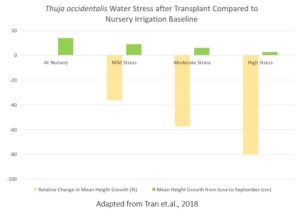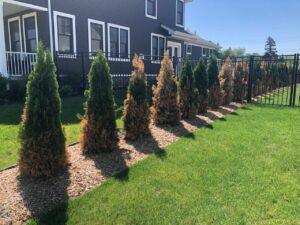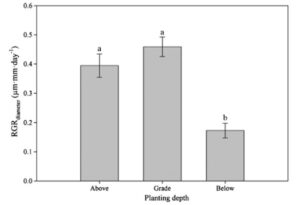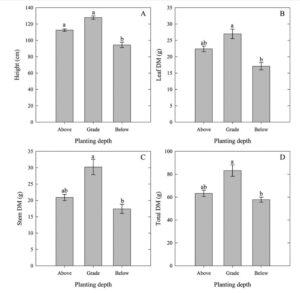
Figure 1. Arborvitae are commonly used as a screen or windbreak in the Midwest landscapes.
Arborvitae (Thuja spp.) fulfill several crucial roles in the landscape, especially windbreaks and screens (Fig. 1). Their relatively fast growth habit, wide variety of available forms, and inexpensive price point make them one of the most common conifers in the Midwest landscape. Due to the ubiquitous use of arborvitae, and their perceived problems, the Green Industry observes many issues on jobsites, specifically on specimens transplanted recently.
Transplant Shock occurs when the root system of a plant can’t supply enough water to the foliage. This is very common with many species, and usually mimics drought stress. The severity of transplant shock depends on species, soil type/quality, available moisture, temperature, growth stage/age of the plant, root loss from the nursery, as well as many other factors. Transplant shock will increase during times of high transpiration (increase in temperature and/or decrease in humidity), which is why plants installed during high temperatures require much more maintenance due to watering needs.
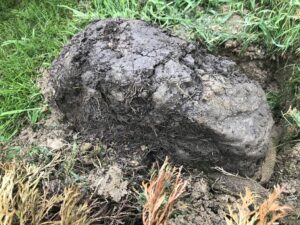
Figure 2. In heavy soils, drainage can be an issue in newly transplanted plants. This picture is the root ball of a B&B arborvitae that had poor drainage in the planting hole.
As the climate is changing in the Midwest, with both flooding (typically in the spring) and droughts (typically in the summer) becoming more common, the maintenance considerations of transplanted arborvitae need to be reevaluated. Irrigation should be considered when installing arborvitae due to increased drought events in the summer. Grade of the planting site needs to be considered prior to installation of plants due to the increased flooding events. Many of the soils in the Midwest contain a high clay content with little drainage, thus planting holes can become ‘bathtubs’ during times of increased rainfall (Fig. 2).
Some of the most common arborvitae problems in the first five years after transplant include:
- Soil moisture issues (typically drought)
- Winter burn
- Planting depth
- Root ball size relative to top growth
- Shade intolerance
Soil moisture:
Excess or minimal soil moisture can cause stress on arborvitae, especially on recently transplanted plants. Irrigating during periods of drought is necessary to prevent shock and stress, especially on arborvitae. Tran et.al. (2018) found that in comparison to ideal conditions in a nursery, landscape water deficits on Thuja occidentalis causing mild, moderate, and high stress conditions; decreased growth by 36, 57, and 80%, respectively. In this same study, the mean growth from June to September in the nursery under mild, moderate, and high water stress conditions, was 14, 9, 6, and 3 cm, respectively (Fig. 3). In addition to reduced growth, water stress can cause significant dieback or even complete death of recently transplanted arborvitae (Fig. 4).
- Figure 3. The relative change in mean height growth (%) and mean height growth from June to September (cm) of four water stress treatments of 0, 25, 50, and 75% of Thuja occidentalis. (Tran et.al., 2018)
- Figure 4. Water stress can cause dieback and death on arborvitae. Most conifers have delayed symptoms, so many times it’s too late to correct the problem once symptoms are visible.
Winter burn:
Winter burn is common on several coniferous species, including arborvitae, and occurs when winds desiccate foliage due to lack of an established root system. Irrigation should continue until freezing temperatures prevent irrigation events so that conifers enter dormancy with less water stress. By preventing stress during the growing season, winter burn will be minimized over the winter months. Spring planted arborvitae have time for more establishment of the root system prior to going into the winter but they require more attention during summer to assure even soil moisture.
Planting depth:
Through the last 20 years landscapers, arborists, and researchers have found that many trees were being transplanted too deep. The decline of the trees over time has become evident through both research and observations. The long-term issues are now well documented, but current research has shown that trees transplanted too deep also cause stress and reduced growth (Bryan, et.al., 2011 and Bryan, et.al., 2010) (Figs. 5 and 6). Not only will growth be reduced after transplant, but over time stem girdling roots will become prevalent in trees that are planted too deep.
- Figure 5. Effect of planting depth on relative growth rate of Quercus viginiana. From Bryan et.al. 2011.
- Figure 6. Effect of planting depth on (A) height (B) leaf dry mass (DM), (C) stem DM, and (D) total DM (leaf, stem, and root DM) of lacebark elm (Ulmus parvifolia). From Bryan et.al. (2010).
Root ball size:
When selecting arborvitae for ball and burlap planting in the landscape it’s important to make sure the root system is of an adequate size to support the amount of top growth present. Trees with small root balls will lose more functional roots during digging operations and will be more prone to transplant stress over a longer period, even several years later.
Shade Intolerance:
As arborvitae age, the lower limbs begin to lose foliage due to the shade response. This occurs on many conifers due to the lack of sunlight that is intercepted from the lower limbs. On newly transplanted arborvitae, a reduction in growth occurs when not in partial to full sun. Kennedy et.al. (2007) showed that shade of 25, 50, and 75% reduced total plant biomass, shoot biomass, and root biomass significantly compared to full sun on spruce, larch, and arborvitae. They found that arborvitae was most affected by the shade treatments by demonstrating the least amount of growth as shade increased (Kennedy, et.al., 2007) (Fig. 7). By planting in areas with minimal shade, this species will encounter less stress and more growth over the first two years after transplanting. It’s also important to remember that when arborvitae are planted too close together they will shade out each other more quickly while also competing for root space, water and nutrients. Wider spacing may take longer for infill but will provide a more viable screen in the long run.
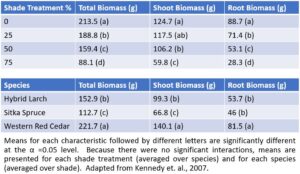
Figure 7. The effect of shade impacts on biomass of spruce, larch, and arborvitae at 0, 25, 50, and 75% shading.
Tips for reducing stress of transplanted arborvitae:
- Irrigate weekly during times of little rainfall to assure even soil moisture throughout the root zone.
- Grade the planting site to remove areas of standing water.
- Check planting depth to reduce deep planting.
- If necessary, remove soil/media from the top of root ball until the top most root or root flare is found.
- Mulch to a depth of 3” and avoid mounding around the base.
- Minimize stress by adding nutrients if indicated by a soil test*.
- *After the first year of transplanting.
- Plant in partial to full sun.
Related Links:
- Top Arborvitae Aggravations: https://www.purduelandscapereport.org/article/top-arborvitae-aggravations/
- Feast or Famine: Landscape plants are struggling due to precipitation: https://www.purduelandscapereport.org/article/feast-or-famine-landscape-plants-are-struggling-due-to-precipitation-extremes/
- Arborvitae Needle Blight: https://www.purduelandscapereport.org/article/arborvitae-needle-blight/
- Start Preparing Trees for Winter and Next Year: https://www.purduelandscapereport.org/article/start-preparing-trees-for-winter-and-next-year/
- Common Abiotic Problems of Ornamentals: Transplant shock: https://www.purduelandscapereport.org/article/common-abiotic-problems-of-ornamentals-transplant-shock/
- Winter Burn: https://hort.extension.wisc.edu/articles/winter-burn/
- Wire Baskets: Leave them or remove them? https://www.purduelandscapereport.org/article/wire-baskets-leave-them-or-remove-them/
References:
Bryan, D.L., Arnold, M.A., Volder, A., Watson, W.T., Lombardini, L., Sloan, J.J., Alarcon, A., Valdez-Aguilar, L.A., Cartmill, A.D. 2010. Planting Depth During Container Production and Landscape Establishment Affects Growth of Ulmus parvifolia. American Society for Horticultural Science. Vol. 45 Issue 1. 7 pgs.
Bryan, D.L., Arnold, M.A., Volder, A., Watson, W.T., Lombardini, L., Sloan, J.J., Alarcon, A., Valdez-Aguilar, L.A., Cartmill, A.D. 2011. Planting depth and soil amendments affect growth of Quercus virginiana. Urban Forestry and Urban Greening. 10: 127-132.
Kennedy, S., Black, K., O’Reilly, C., and Dhubain, A. 2007. The impact of shade on morphology, growth, and biomass allocation in Picea sitchensis, Larix x eurolepis, and Thuja plicata. New Forests 33, 139.
Tran, N., Stoochnoff, J., Graham, T., Downey, A., and Dixon, M. 2018. Irrigation management to enhance the quality, efficiency, and survival of transplanted nursery trees. Acta Hortic. 1205. Pgs. 447-452.
